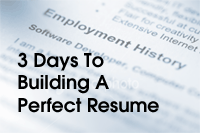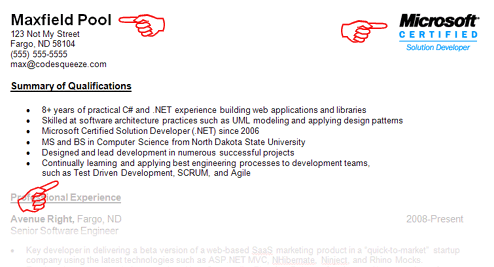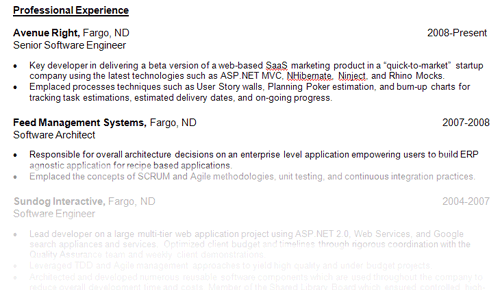How To Organize A Gosh-Darn Good Resume
Filed Under 3 Days To Building A Perfect Resume

This is Part #3 of the 3 Days To Building A Perfect Resume series.
Last week we talked about how to sell yourself and the best way to present your skills section. Now is the time to put it all together in one single and easy to use template. Ready? Here we go…
Highlight Your Strengths Early
Managers and HR people have just as busy days as you or I. Simply put, when managers are weeding through resumes they are scanning them quickly looking for the good ones and trashing the rest. As a result, don’t make any resume reader hunt for your strengths – provide them clearly at the very top.

As you can see above, I have highlighted at the top 3 big things:
- My name (which is extra helpful that is not an everyday name)
- MCSD Logo (color, image, and brand name recognition make it stand out)
- Summary of qualifications list
If you look at how people consume computer screens using the F pattern; hopefully, this resume header will grab the attention of a potential reader. First the name pops out…then the image…now back down to the list of qualifications. If we can get the reader engaged up to this point, I guarantee they will continue to read the rest of your resume (which is much better than getting it thrown in the trash).
Additionally, I really like this format as it considerably condensed my resume. I was able to remove the sections Education and Certifications while expanding on the section Summary.
Skip The ‘Goal’ Section
One thing I use to be guilty of is placing the “Goal” section at the top of my resume. You know, the ones that look like this:
Goal: To become a programmer at Smith, Smith, and Smith Lawyer Firm
The reasoning for doing this is to “personalize” the resume and have people believe that you have taken a special minute of your time to apply for their company. I hate this for a couple of reasons:
- Takes up valuable space
- Provides no informational worth about your skills
- Wastes the readers time
- Increases possibility of putting the wrong company name (I have seen it and done it)
The absence this section will not cause you to lose a job, but looking like a suck-up might. Ditch this section and give yourself some more space.
Brutally Summarize Your Professional Experience
Unless you are straight out of college and scrapping for content to put on your resume, you probably have enough professional history to fill a small novel. Yet, we are forced to put in on less than a single page in bullet point format. That’s cool, but it isn’t going to happen unless you trim out some of the fat.
Be brutal. List out your professional experience, read it, cut it in half. Read it again, and cut that half in half. You can not (and should not) list every war story in this section. Your resume is the pamphlet of your career and not the novel itself.

Personally, I recently had to trim off my very first job/internship as I didn’t have the additional room. It stung, but it had to be done.
Dig Deep
You probably know more than you think, and have done more than you are letting on. For example, I have an entire section dedicated to Publications. What else could you put on your resume? Here are some additional ideas:
- Author of blogs/journal articles/books
- Local/National User Groups
- Nonprofit/OSS experience
- Non-technical domain experience applicable to the hiring company
Prioritize them and fill out your resume with them. It will only help if it is not complete BS or fluff.
Hint That There’s Even More
Never include your references with your resume, unless specifically asked to do so as a requirement of submission. This is because you want them to know that there is more and to start a conversation by asking for it.
If you take a look at my resume below, I end my resume with this:
* Extended resume (previous to 2000) and references are available upon request
If they made it to the bottom of my resume, they want more, and what a better way than to give them a reason to call you and start a conversation. Extended resume? How much does this guy know? I wonder who is references are?
Optimize For Your Audience
A great reader comment on Part #1 – Sell Yourself With Business Benefits reminded me to make note of this:
It’s a good idea to try and figure out who is likely to be reading your resume… if it’s me, you can skip the management fluff completely. What I really want to know is what matters to the candidate. –Barry Dahlberg
Personally, I created a resume that is somewhere in the middle (because I am lazy). It speaks in both geek and benefits and is hopefully good enough to start a conversation with both parties. If you feel it to be necessary create separate resumes for the separate interviews and bring them with you. It is highly probable that each interviewer will bring a copy of your “generic” resume, but you can give them a more targeted one when you are face-to-face.
And that’s it! There is nothing hard about creating a gosh-darn good resume, and in fact I am about to make it easier. You can easily download both my personal resume and the template I use so you can have a good example to work off of. Good luck out there!
10 Responses to “How To Organize A Gosh-Darn Good Resume”



[…] How to Organize a Gosh Darn Good Resume (Max Pool) […]
[…] Max Pool tells us How To Organize A Gosh-Darn Good Resume […]
How do you suggest “brutally summarize” nearly 3 decades of software development across PC/micros, mid-range and mainframe (languanges and databases notwithstanding) AND with jobs ranging from insurance, banking, hospitality, utilities/energy, healthcare and manufacturing?
Its just not possible to get this sort of resume down below 4 pages. No matter how I try, something important and relevant has to be removed.
Any sugguestions? My resume is a cramped 4 pages printed. I dont like it that way but that is what it is after 28 years of IT work.
@Jim –
“No matter how I try, something important and relevant has to be removed.”
It’s easy to get emotionally attached to work that you have accomplished but you have to realize that not a single person is interested in reading a 4 page resume.
Personally, I only care what a candidate has done in the last 2-4 years as it really shows me who they are today, not who they were in the past. Experience before 2000 (let alone 20 years ago) is outdated and probably irrelevant. As much as it hurts – cut it out of your main resume, and you can always have your 4 page monster as your “extended” resume.
@Jim
As for summarizing, you just did a pretty good job at doing it in your comment. That was 3 decades of experience in one paragraph. 🙂
@Henrik: haha! yea. try giving that to an employer or client to convince them that you know what you’re doing! 🙂
[…] How To Organize A Gosh-Darn Good Resume (tags: tips resume jobhunting career) Daily Links […]
“Personally, I only care what a candidate has done in the last 2-4 years as it really shows me who they are today, not who they were in the past.”
It IS the past who makes us who we are today. If someone worked on low-level Assembler device driver info 10 years ago, I want to know. It gives me an insight into his personality and tells me who they are (and have been) the past decade.
If someone’s resume is beefy for the past 10 years and the last 2 years is light – its sheds a different light on them.
Conversely, if someone’s resume shows responsiblities continually built up the past 10 years but leveled off 2 years ago – it sheds another light on them.
I dont want anything thrown out. Its historical and it says a LOT. Hand me 5-6 page resumes any day. I want to know. Everything.
The best way to summarize your career to a single page resume is to list only those experiences and capabilities which are relevant to the job to which you are applying to. Great tips for creating a gosh-darn good resume.
[…] one glaring disagreement between our opinions however; Max recommends putting that big Microsoft Certified Solutions Developer logo up front to make it stand out, while I stated that putting certifications up front is a bad idea. I totally […]